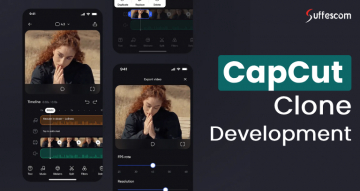Aster DEX Clone Development | Build a Next-Gen Perpetual Futures DEX

Aster Perpetual DEX is a next-generation decentralized perpetual exchange built specifically for leveraged futures trading. Unlike traditional CEXs, Aster is a non-custodial, trustless exchange designed for seamless trading of digital assets with leverage. Powered by smart contracts and blockchain technology, the Aster Decentralized Exchange offers a number of core benefits compared to more traditional systems: guaranteeing transparency, speed of settlement, and lower fees.
Overview of Aster Decentralized Exchange
The Aster DEX clone assuredly packs the robust architecture of its base, guaranteeing perpetual futures, spot trading, and a range of sophisticated order types. It combines a high-speed matching engine, liquidity pools, and oracle-based price feeds that maintain accurate, real-time trading data. Users can trade directly from their wallets without intermediaries, making it a perfect choice for DeFi enthusiasts who value security, autonomy, and decentralization.
Why Aster matters in perpetual futures?
Perpetual futures are a kind of derivative contract without expiry dates. They allow traders to hold positions indefinitely, earning or paying funding rates. In particular, the Aster Perpetual DEX combines decentralized governance with advanced risk management.
These include fully transparent liquidation protocols, cross-margin or isolated-margin alternatives, and deep liquidity, all these without needing centralized custody. Because of features such as these, DEX trading platforms like Aster have gained significant traction among professional and retail traders who need both flexibility and security.
Quick Comparison with CEX Models
While centralized exchanges like Binance or Coinbase keep users' funds in custody and control order execution, Aster DEX eliminates this middleman. Here's why it matters:
1. Ownership: Traders hold full ownership of their crypto assets.
2. Security: Non-custodial wallets reduce the likelihood of hacks.
3. Transparency: Smart contracts automate settlements and liquidations.
4. Global Access: Everyone can trade with a supported wallet, without KYC restrictions - depending on the deployment.
How Does Aster Perpetual DEX Work?
To understand the real value of an Aster Perpetual DEX, it helps to break down how the platform functions behind the scenes. Unlike centralized exchanges that rely on custodial infrastructure, the Aster decentralized exchange operates through a fully transparent, smart-contract–driven architecture. This combination of on-chain trust and off-chain efficiency is what makes every Aster like DEX trading platform both reliable and incredibly fast.
1. Core Mechanism: Funding Rates & Perpetual Markets
At the center of the system are perpetual futures markets, which allow traders to hold positions indefinitely. Because these markets have no expiry dates, the platform uses funding rates to keep the contract price aligned with the underlying asset. This ensures that markets remain stable and fair, while also reducing price manipulation risks. As a result, an Aster DEX clone can offer the same high-performance perpetual markets that traders expect from advanced decentralized derivatives platforms.
2. Order Execution & Liquidity Model
To maintain a smooth trading experience, the Aster crypto trading DEX combines liquidity pools with a smart order-matching layer. Instead of relying entirely on an AMM or a traditional order book, it uses a hybrid model that minimizes slippage and improves execution speed. This means traders receive consistent liquidity across market conditions, something many decentralized exchanges struggle to achieve.
3. On-Chain vs. Off-Chain Architecture
Aster’s efficiency comes from the way it divides operations between on-chain and off-chain processes.
- On-chain, smart contracts handle settlement, margin calculations, risk checks, and liquidations, ensuring transparency and security.
- Off-chain, the platform manages trade routing, price aggregation, and order book updates for low-latency performance.
By blending these two systems, the Aster Decentralized Exchange provides speed similar to centralized exchanges while retaining the security benefits of DeFi.
4. Advanced Risk Engine & Liquidation Mechanisms
To keep the platform stable, Aster uses a real-time risk engine that constantly monitors traders’ positions. When a position becomes too risky, the liquidation process kicks in automatically, executed entirely on-chain for accuracy and transparency. Furthermore, unlike most DEXs, Aster allows yield-bearing assets like asBNB and USDF as collateral, enabling capital-efficient margin trading while positions continue earning yield. These features have contributed to $1.32B in 24-hour trading volume, $933M in perpetual volume during Rocket Launch, and $1.48B in TVL, making it one of the fastest-growing perpetual DEXs of Q4 2025.
5. Price Feeds & Oracle Integrations
Accurate pricing is essential for perpetual futures. For this reason, Aster integrates multiple Oracle sources to deliver real-time, tamper-resistant price data. This ensures that both funding rates and liquidation triggers operate correctly. These Oracle modules are also available inside any Aster Clone Software, allowing developers to replicate the platform’s precision.
6. MEV Protection & Fair Execution
To prevent front-running and unfair trade manipulation, the Aster DEX clone architecture includes MEV protection layers. These mechanisms ensure that every transaction is executed fairly, improving user trust and making the platform more competitive compared to alternatives such as Hyperliquid DEX.
Why Choose an Aster Clone Script?
A modern Aster-style DEX clone offers several advantages that make it ideal for startups, trading platforms, and DeFi businesses:
1. Non-Custodial & Secure by Design
Users retain complete ownership of their funds since all assets stay inside their personal wallets, eliminating centralized custody risks.
2. Perpetual Futures with No Expiry Limits
Let traders open long or short positions on BTC, ETH, and top altcoins using leverage, without worrying about settlement dates or contract rollovers.
3. Hybrid AMM
Combining liquidity pools with an order-book matching system ensures deeper liquidity, fewer price gaps, and lightning-fast trade execution.
4. Super-Low Trading & Gas Fees
Smart contract optimization drastically reduces operating costs, making every trade more efficient and more profitable for users.
5. Built for Multi-Chain Expansion
Launch your DEX across top networks like Ethereum, BNB Chain, Polygon, Arbitrum, Base, and others to maximize user reach and liquidity accessibility.
Launch Your Own Aster-Like DEX Trading Platform
Ready to build a next-gen decentralized perpetual exchange. Our experts can help you launch a fully customized Aster-like DEX trading platform.
Essential Features of an Aster-Like DEX Trading Platform
These essential features make it easy for startups and enterprises to deploy a high-performance decentralized exchange using Aster Clone Software, delivering real-time trading, multi-asset support.
1. Real-Time Perpetual Trading
An Aster Clone Trading Platform enables ultra-fast perpetual futures trading with real-time position updates, accurate P&L tracking, and instant execution. Aster itself recorded $371M+ in trading volume within the first 24 hours, showcasing how real-time perpetual trading can scale rapidly on a decentralized system.
2. Multi-Asset Support
The Aster DEX clone supports a wide range of cryptocurrencies for perpetual contracts, spot trades, and margin collateral. This multi-asset flexibility empowers traders to diversify strategies across different markets. It is similar to how the Aster Perpetual DEX attracted 330,000+ new users on TGE day one due to its broad asset accessibility.
3. Oracle Price Feeds
Powered by decentralized price oracles, the platform ensures fair price execution, reduced manipulation risk, and accurate funding calculations. Oracle feeds are crucial for an Aster- like DEX trading platform, especially in volatile markets where price accuracy directly impacts liquidations and leverage safety.
4. Non-Custodial Wallets
Users trade directly from their self-custody wallets, maintaining full ownership of their assets at all times. This aligns with the core principle of any Aster decentralized exchange, where traders avoid centralized risks like exchange hacks or withdrawal freezes.
5. Risk Engines & Liquidation Modules
The risk engine continuously monitors margin levels, leverage limits, and position health. If a position becomes unsafe, the liquidation module executes automatically to prevent systemic failures. This is the same mechanism that keeps the Aster crypto trading DEX stable even during high-volatility events, helping the platform achieve over $1B+ TVL within a single day of launch.
Build Your Own Aster-Style DEX With Proven Performance
Replicate Aster’s $371M+ first-day trading volume using our advanced Aster clone software. Launch a secure, high-speed decentralized platform today.
Additional Features to Strengthen Aster Clone Trading Platform
1. Spot Trading Module
Enable users to buy and sell crypto assets directly at market or limit prices with real-time execution. Ideal for beginners and pro traders who want simple, non-leveraged trading.
2. Swap Interface (AMM Swaps)
A one-tap swapping experience powered by automated market makers (AMMs). Users get fast, permissionless token swaps with minimal slippage.
3. Liquidity Mining & Farming Pools
Reward users for supplying liquidity through token incentives and yield farming campaigns. Boosts platform TVL and strengthens community participation.
4. Referral Commission System
Let users earn a percentage of trading fees by inviting others. Helps drive organic user acquisition and increases daily trading volumes.
5. Full Portfolio & PnL Tracking
Provides real-time dashboards showing open positions, profit/loss, balances, and trading history. Gives users complete visibility into their performance.
6. Mobile-Optimized Trading UI
A responsive, app-like interface that delivers smooth trading on any device. Ensures high usability for traders on the move.
7. TradingView Charts
Professional-grade candlestick charts with indicators and drawing tools. Allows traders to conduct technical analysis without leaving the platform.
8. Gasless Trading
Users can trade without paying gas fees by leveraging relayers or meta-transaction infrastructure. Improves accessibility, especially for high-frequency traders.
Benefits of DEX Trading Platform Similar to Aster
Choosing to build a DEX Trading Platform Like Aster offers crucial functional, security, and business advantages. As the Aster Decentralized Exchange model is engineered for speed, transparency, and on-chain fairness, your platform can replicate the same capability using an optimized Aster Clone Software.
1. True User Ownership & Full Transparency
A DEX like Aster allows users to maintain full control of their assets via non-custodial wallets. Each trade, each settlement, and each liquidation is on-chain, bringing trust and removing the risks associated with centralized exchanges.
2. Lower Trading Fees Compared to CEX Models
Because an Aster Crypto Trading DEX removes the middlemen, its execution cost drastically declines. Makers, takers, and high-frequency traders benefit from the much lower fees while improving the overall trading volume.
3. Strong Liquidity Mechanisms
Aster-inspired platforms combine deep on-chain liquidity with fast off-chain matching. This hybrid model minimizes slippage, allows for large orders, and facilitates perpetual markets, which even operate well during periods of volatility.
4. Secure Smart Contract Architecture
A DEX trading platform similar to Aster uses audited smart contracts, oracle-verified prices, MEV-resistant execution, and robust risk engines. This multi-layer security approach protects traders from manipulation, exploits, and front-running.
5. Multi-Asset Support & Global Market Access
Your Aster-like DEX trading platform will be able to support dozens of crypto assets, enabling perpetual futures, margin trading, and spot swaps across multiple chains. This increases the number of potential users and enhances trading activity.
6. Scalability for Growing Trading Demand
Because Aster-style protocols operate on multi-chain architecture, your Aster clone trading platform can scale rapidly. It can process thousands of trades per second without compromising finality or execution speed.
7. Built-in DeFi Compatibility
DEXs based on Aster onboard seamlessly into the greater DeFi ecosystem, consisting of wallets, cross-chain bridges, yield modules, liquidity farming, and other composable protocols; this enhances utility and uncovers new revenue streams.
8. Governance & Token Utility Expansion
If you introduce a native token like $ASTER, your DEX gets built-in governance, staking, rewards, and liquidity incentives. This further cements community ownership and the long-term value of the platform.
Scale Like Aster: Over 330,000 Users in Day One
Leverage our DEX Trading Platform to offer perpetual trading, hybrid liquidity, and multi-chain support that attracts users from day one.
Aster vs. Hyperliquid – Which DEX Model Fits Your Business?
| Feature | Aster Perpetual DEX / Aster DEX Clone | Hyperliquid DEX | Why It Matters for Your Business |
| Speed | High-speed trade execution using hybrid on-chain/off-chain architecture to reduce latency and slippage. | Ultra-fast execution optimized for high-frequency trading. | Choosing a DEX trading platform like Aster or Hyperliquid depends on your user base and trading volume needs. |
| Liquidity | Deep liquidity pools with automated market-making (AMM) and cross-chain support. | Concentrated liquidity and aggregated pools for professional traders. | Platforms like an Aster Clone Trading Platform ensure smooth trading and minimal slippage. |
| Settlement | On-chain settlements for transparency with automated smart contract execution. | Semi-off-chain settlements for faster processing. | Decide between full decentralization (Aster Perpetual DEX) and speed-focused models (Hyperliquid DEX) based on business priorities. |
| Ecosystem / APIs | Supports integrations with wallets, price oracles, staking, and governance tools. Internal link → decentralized perpetual exchange. | Offers advanced APIs for algorithmic trading and third-party tools. Internal link → perpetual trading app development. | Choosing a DEX trading platform similar to Aster ensures compatibility with external tools and future scalability. |
Token Economics – What Is $ASTER Token?
The $ASTER token is the native utility and governance asset that powers the entire Aster Perpetual DEX ecosystem. Just like other leading decentralized derivatives platforms, the token is designed to enhance user participation, maintain liquidity, and strengthen the overall performance of an Aster Decentralized Exchange or any Aster DEX clone built for business use.
1. Utility & Governance
The $ASTER token serves multiple roles within the network.
Users can utilize it for discounted trading fees, margin support, and access to premium features on an Aster-like DEX trading platform. Beyond utility, the token also gives holders governance rights, allowing them to vote on proposals, system upgrades, incentive programs, and other protocol-level decisions. This governance model ensures the Aster crypto trading DEX remains community-driven and fully decentralized.
2. Staking
Staking is one of the core value drivers of the $ASTER token. Traders and token holders can stake their ASTER tokens to earn passive rewards, strengthen network security, and gain exclusive benefits inside the Aster DEX clone ecosystem. Staking pools play an essential role in supporting liquidity and maintaining the platform's economic equilibrium, making them an attractive feature for long-term users.
3. Rewards & Liquidity Incentives
To encourage participation and sustained liquidity, $ASTER token offers multiple incentive mechanisms. Liquidity providers earn rewards for contributing to trading pools, while active traders may receive periodic rebates, bonuses, or yield-based incentives. These reward structures help maintain a healthy flow of liquidity on the Aster Perpetual DEX, making it easier for businesses to build a competitive and engaging Aster-like DEX trading platform.
$ASTER Token Allocation
Aster adopts a community-first tokenomics framework, ensuring long-term sustainability rather than short-term speculation. Out of the total 8 billion $ASTER tokens, more than 80% is allocated directly to users, ecosystem growth, and decentralized development. This structure helps the Aster Decentralized Exchange maintain healthy liquidity.
1. Airdrop & Community Rewards – 53.5% (4.28 Billion)
A majority share is dedicated to traders, stakers, Rocket Launch participants, and loyal community members. This ensures that the most active contributors to the Aster crypto trading DEX receive the highest share of rewards.
2. Ecosystem & Grants – 30% (2.4 Billion)
A large portion is reserved for APX migration, cross-chain partnerships, liquidity mining programs, and developer grants. This treasury supports ecosystem expansion and enables builders to innovate on top of an Aster-like DEX trading platform.
3. Treasury – 7% (560 Million)
Allocated as long-term reserves, the treasury supports governance, research, critical upgrades, and protocol sustainability. This ensures that an Aster-style decentralized exchange can keep scaling over the years.
4. Team & Advisors – 5% (400 Million)
This allocation is locked with a strict cliff and multi-year vesting schedule to ensure full alignment between contributors and long-term protocol growth. By vesting rewards over several years, Aster reduces the risk of early sell-offs and strengthens the credibility of an Aster-like DEX trading platform.
5. Liquidity & Listings – 4.5% (360 Million)
These tokens support market-making, cross-chain liquidity pools, and exchange listings. Maintaining deep liquidity is essential for tightening spreads, reducing slippage, and ensuring smooth execution across the Aster crypto trading DEX.
Why This Token Model Matters for Aster and Your Aster Clone Software?
Aster’s tokenomics go beyond simple allocations. They create a circular incentive economy that continually strengthens the protocol. Because such a large share of $ASTER is committed to community engagement, trading incentives, and ecosystem expansion.
This model benefits anyone building their own DEX trading platform like Aster, because:
- Incentives reward real adoption, not insider speculation
- Trading activity increases TVL, strengthening liquidity
- Staking and rewards encourage long-term user retention
- Buybacks via Rocket Launch events help stabilize token value
- Developer grants attract builders, expanding ecosystem utility
Development Process for an Aster-Like DEX Trading Platform
Building a DEX trading platform like Aster requires a precise, security-driven, and highly systematic approach. Below is a step-by-step workflow that ensures your Aster clone is scalable, compliant, and ready for perpetual trading at an institutional-grade level.
1. Requirement Mapping & Technical Discovery
The process begins with requirement mapping, where the development team analyzes your business goals, trading model, supported assets, leverage limits, and liquidity strategy. This step ensures the Aster-like DEX is fully aligned with your product vision, regulatory boundaries, and user expectations.
2. UI/UX Design & System Architecture Planning
Next, the team creates UI/UX wireframes and architecture blueprints to define how traders will interact with the platform. This includes designing trading dashboards, charts, order flows, and wallet integration. At the same time, architects finalize the DEX’s core components, such as AMM engine, oracle layer, risk engine, settlement contracts, and multi-chain deployment plan. It is similar to modern perpetual DEX models like Aster and Hyperliquid.
3. Smart Contract Development & Core Logic Implementation
Once the architecture is locked, developers begin crafting smart contracts for perpetual markets, staking, liquidity pools, oracle feeds, funding rates, and liquidation logic. In an Aster clone, smart contracts are engineered to be non-custodial, audit-ready, and optimized for gas efficiency, ensuring secure perpetual futures trading across chains.
4. Integration, Quality Assurance & Security Testing
After the core logic is built, the platform undergoes rigorous integration testing. This includes:
- Oracle price-feed validation,
- Funding rate recalculations,
- Cross-margins operations,
- Stress testing on the hybrid liquidity engine, and
- Complete smart contract auditing to eliminate attack vectors.
This step confirms that your Aster-like perpetual DEX performs reliably under real-world market volatility.
5. Deployment, Mainnet Release & Post-Launch Support
Finally, the DEX is deployed on the selected blockchain networks such as Ethereum, BNB Chain, Polygon, Arbitrum, Optimism, or multi-chain setup. After deployment, the team handles monitoring, upgrades, bug fixes, token integration, and liquidity bootstrapping, ensuring smooth platform operations from day one.
Tech Stack for Building an Aster-Like DEX Trading Platform
| Category | Technologies / Tools | Purpose |
| Blockchain Networks | Ethereum, BNB Chain, Polygon, Arbitrum, Optimism, Base, Solana (optional) | Deploy smart contracts, ensure multi-chain connectivity similar to Aster DEX. |
| Smart Contract Development | Solidity, Rust (for Solana), Hardhat, Foundry, Truffle | Build perpetual futures, AMM, staking, liquidity, and governance contracts. |
| Frontend (Web + Mobile) | React.js, Next.js, Vue.js, React Native | Build the trading UI for an Aster-like DEX trading platform, including charts & order interfaces. |
| Backend Services | Node.js, GoLang, Python | Manage APIs, off-chain data, order book relayers, notifications & analytics. |
| Database & Storage | PostgreSQL, Redis, MongoDB, IPFS | Store user profiles, trading analytics, logs, and decentralized storage of metadata. |
| Oracles | Chainlink, Pyth, Band Protocol | Deliver real-time pricing for perpetual markets crucial for Aster Perpetual DEX Work. |
| Liquidity Engine | Custom AMM modules + Off-chain Order Book Servers | Enable hybrid liquidity—similar to Aster’s perpetual markets. |
| Wallet & Web3 Integration | MetaMask, WalletConnect, Phantom, Web3.js, Ethers.js | Enable non-custodial onboarding and seamless transaction signing. |
| Security & Auditing Tools | OpenZeppelin, Slither, MythX, Tenderly | Smart contract analysis, simulation, debugging, and ongoing security monitoring. |
| Trading Charts & UI Libraries | TradingView Charting Library, Recharts, D3.js | Power K-line charts and advanced order views for Aster-like DEX dashboards. |
| DevOps & Infrastructure | AWS, Docker, Kubernetes, Nginx, Cloudflare | Run scalable nodes, backend services, and load-balanced trading engines. |
| Monitoring & Analytics | Grafana, Prometheus, The Graph, Dune Analytics | Real-time monitoring of trades, funding rates, liquidation data & performance metrics. |
| Testing & QA Stack | Mocha, Chai, Jest, Cypress, Foundry Tests | Ensure reliability of smart contracts, UI, APIs, and trading modules. |
What Are the Estimated Build Costs and Timelines for Aster-Style DEX Development in 2026?
Building a high-performance, Aster-style DEX trading platform complete with perpetual futures, hybrid liquidity, multi-chain support, and institutional-grade security requires significant technical depth. In 2026, the estimated development cost ranges from $50,000 to $1,00,000, depending on your architecture, chain support, smart contract complexity, and liquidity requirements.
Businesses looking for a faster and more cost-efficient launch can significantly reduce expenses by using Aster clone software or advanced white-label DEX infrastructures, which cut engineering hours, audit cycles, and integration time.
Estimated Timeline for Aster-Like DEX Trading Platform Development
| Phase | Timeline | What You Receive |
| Phase 1: Spot + AMM + Testnet Release | ~6 Months | Core DEX setup with AMM pools, swapping features, wallet integration, basic liquidity modules, and testnet deployment. |
| Phase 2: Perpetual Markets + Multi-Chain Integration + Beta | ~9 Months | Perpetual futures engine, funding rate mechanism, oracle integration, multi-chain bridging, off-chain order relayer & beta release. |
| Phase 3: Full Hybrid DEX + Compliance | ~12 Months | Hybrid AMM + order book infrastructure, risk engine upgrades, compliance modules, governance features, audits, and production-grade mainnet launch. |
Why Choose Us to Build an Aster Like DEX Trading Platform?
As a leading decentralized exchange development company, we deliver Aster-like DEX platforms built for high performance, robust security.
1. Experts in DEX Development
We specialize in building secure, high-performance perpetual and spot DEX platforms tailored for scalability, speed, and long-term reliability.
2. Custom Aster-Like DEX Architecture
We specialize in building Aster DEX clone platforms with a fully tailored engine hybrid liquidity, oracle-based pricing, real-time risk monitoring, liquidation logic, staking modules, and governance frameworks.
3. Enterprise-Level Security
Your exchange is secured with multi-layer protection including smart contract auditing, sandbox testing, encryption modules, and attack-resilient architecture.
4. Scalable Multi-Chain Deployment
We deploy your DEX across Ethereum, BNB Chain, Arbitrum, Polygon, Base, or any L2, ensuring ultra-fast throughput and low operating cost.
5. Complete Crypto Exchange Solutions
As a trusted cryptocurrency exchange development company, we offer end-to-end development from architecture and smart contracts to deployment and audits.
6. Dedicated Post-Launch Support
Our team continuously monitors, upgrades, and optimizes your platform to maintain liquidity depth, performance stability, and user growth.
FAQs
1. What is an Aster Clone?
An Aster Clone is a custom-built decentralized perpetual trading platform that replicates the core features of Aster DEX, such as 100x leverage, hybrid liquidity, oracle price feeds, and non-custodial trading. It allows businesses to quickly launch their own perpetual futures exchange.
2. How does an Aster-like Perpetual DEX generate revenue?
A DEX similar to Aster earns through trading fees, funding rates, liquidation penalties, token utilities, and LP fees. Additional revenue can come from listing fees, referral programs, and market-making spreads.
3. How much does it cost to build an Aster clone platform?
The cost depends on features, blockchain networks, and customization requirements. Typically, Aster Clone development ranges from 50,000 to $100,000+ depending on advanced modules like multi-chain support, hybrid liquidity, or DAO governance.
4. Is the Aster Clone fully decentralized?
Yes. It operates with on-chain smart contracts for settlement, non-custodial wallets, oracle-powered pricing, and DAO governance. Off-chain matching engines can be added for faster order execution while keeping settlement decentralized.
5. Can I add support for multiple blockchains?
Absolutely. Aster-like DEX platforms can integrate Ethereum, BNB Chain, Polygon, Arbitrum, Optimism, Solana, Base, and more, depending on your scalability and liquidity goals.
6. How secure is an Aster clone trading platform?
The platform is secured through audited smart contracts, oracle price feeds (Chainlink/Pyth/Band), anti-MEV protection, insurance funds, and real-time risk engines that prevent manipulation and ensure safe trading.
7. Does the Aster clone support 100x leverage?
Yes. You can enable leverage up to 100x for perpetual contracts with features like cross/isolated margin, auto-liquidation, and funding rate mechanisms.
8. What liquidity model does an Aster-like DEX use?
It uses a hybrid liquidity engine combining AMM pools with off-chain order relay, ensuring:
- Deep liquidity
- Low slippage
- Faster matching
- Reduced price manipulation
9. Can I launch my own token with the Aster clone?
Yes. You can deploy a native token for governance, staking, liquidity incentives, and fee discounts, similar to the $ASTER token model.






